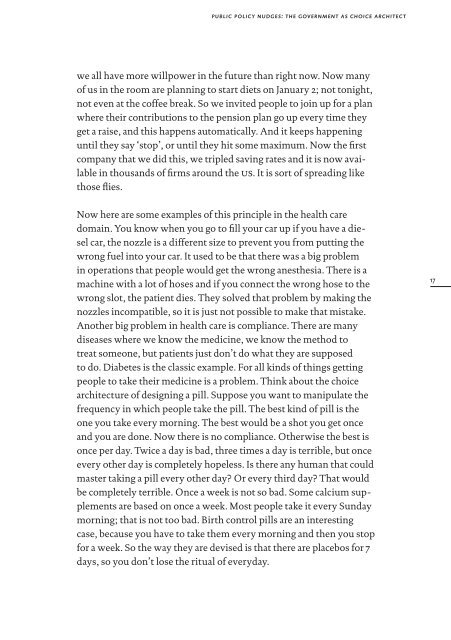De overheid als keuzearchitect? - Wetenschappelijke Raad voor het ...
De overheid als keuzearchitect? - Wetenschappelijke Raad voor het ...
De overheid als keuzearchitect? - Wetenschappelijke Raad voor het ...
You also want an ePaper? Increase the reach of your titles
YUMPU automatically turns print PDFs into web optimized ePapers that Google loves.
public policy nudges: the government as choice architect<br />
we all have more willpower in the future than right now. Now many<br />
of us in the room are planning to start diets on January 2; not tonight,<br />
not even at the coffee break. So we invited people to join up for a plan<br />
where their contributions to the pension plan go up every time they<br />
get a raise, and this happens automatically. And it keeps happening<br />
until they say ‘stop’, or until they hit some maximum. Now the first<br />
company that we did this, we tripled saving rates and it is now available<br />
in thousands of firms around the us. It is sort of spreading like<br />
those flies.<br />
Now here are some examples of this principle in the health care<br />
domain. You know when you go to fill your car up if you have a diesel<br />
car, the nozzle is a different size to prevent you from putting the<br />
wrong fuel into your car. It used to be that there was a big problem<br />
in operations that people would get the wrong anesthesia. There is a<br />
machine with a lot of hoses and if you connect the wrong hose to the<br />
wrong slot, the patient dies. They solved that problem by making the<br />
nozzles incompatible, so it is just not possible to make that mistake.<br />
Another big problem in health care is compliance. There are many<br />
diseases where we know the medicine, we know the method to<br />
treat someone, but patients just don’t do what they are supposed<br />
to do. Diabetes is the classic example. For all kinds of things getting<br />
people to take their medicine is a problem. Think about the choice<br />
architecture of designing a pill. Suppose you want to manipulate the<br />
frequency in which people take the pill. The best kind of pill is the<br />
one you take every morning. The best would be a shot you get once<br />
and you are done. Now there is no compliance. Otherwise the best is<br />
once per day. Twice a day is bad, three times a day is terrible, but once<br />
every other day is completely hopeless. Is there any human that could<br />
master taking a pill every other day? Or every third day? That would<br />
be completely terrible. Once a week is not so bad. Some calcium supplements<br />
are based on once a week. Most people take it every Sunday<br />
morning; that is not too bad. Birth control pills are an interesting<br />
case, because you have to take them every morning and then you stop<br />
for a week. So the way they are devised is that there are placebos for 7<br />
days, so you don’t lose the ritual of everyday.<br />
17

















